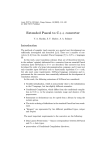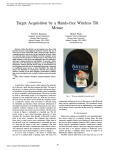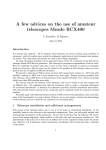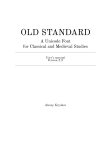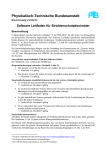Download Wiley Trustworthy Compilers
Transcript
1
AL
Chapter
MA
TE
RI
Introduction
•
•
CO
PY
RI
GH
TE
D
This chapter is an introductory one. It introduces the basic concept of a trustworthy compiler used throughout the book. Also, it covers the basics of compilers and compilation from a modern viewpoint—different kinds of compilers
and the phases of compilation—and summarizes compilers history and compiler development technologies.
In traditional meaning, a compiler is a program that translates the source
code written in some high-level language (Pascal, C, C++, Java, C#, etc.) to
object code—native machine code executable on some hardware platform
(e.g., ×86, ×64, or Scalable Processor ARChitecture [SPARC]). In this sense,
compilers seem to be an old and well-studied topic. However, right now, the
concept of a compiler is much wider. Also, there are many reasons stimulating
further growth of compilers and progress in compiling techniques, in
particular:
the development and wide spread of novel hardware architectures, like
multi-core, Very Long Instruction Word (VLIW), Explicit Parallelism
Instruction Computers (EPIC), and others, that require much more
“intelligence” from the compiler than before, in particular, require from
the compiler to perform static parallelizing of program execution and
scheduling parts of hardware working in parallel;
the progress and wide popularity of two novel software development
platforms, Java and .NET, whose computing and compilation model
Trustworthy Compilers, by Vladimir O. Safonov
Copyright © 2010 John Wiley & Sons, Inc.
1
2
INTRODUCTION
•
•
•
•
1.1
stimulated research in new approaches to compilation, just-in-time (JIT)
and ahead-of-time (AOT), that make runtime performance of programs
on those platforms more optimal;
the support of multi-language programming on .NET platform. On that
new platform, different modules of a large application can be developed in
any languages implemented for .NET, for example, C#, Visual Basic.NET,
Managed C++.NET, and others. For that reason, now we are witnessing
a real compiler development boom for .NET platform (exceeding the
previous compiler boom of the 1970s when a lot of new programming
languages were invented): more than 30 languages are already implemented for .NET, and the number of implemented languages continues
to grow. We are also witnessing a related boom of compiler development
tools (ANother Tool for Language Recognition [ANTLR], SableCC,
CoCo/R, and hundreds of others);
the popularity of Web programming that stimulated the evolution of Web
programming languages with extensive dynamic typing features (Perl,
Python, Ruby, JavaScript/ECMAScript). In this relation, the task of their
efficient implementation is very important;
the popularity of trustworthy computing (TWC) and, therefore, the challenge to make compilers more trustworthy, verifying, and verified, as
described below in this chapter and in Chapter 2;
the rapid development of mobile devices, and the related progress in
developing compilers for mobile platforms.
THE CONCEPT OF A TRUSTWORTHY COMPILER
Keeping in mind the TWC [1] paradigm that inspired this book as well as our
previous book [1], one of the major issues in compiler development should be
how to make a compiler trustworthy and what is a trustworthy compiler. Here
is our vision of trustworthy compiling and of the concept of a trustworthy
compiler, based on our own compiler experience, and on related heuristics
and pragmatics.
A trustworthy compiler is a compiler that satisfies the following conditions
(or, practically speaking, at least some of the conditions) listed below:
1
2
A compiler that generates a trustworthy object code. The users will trust
the compiler, at first, if the object code generated by the compiler (any
kind of native code, or virtual code) is trustworthy, since code generation
is the primary task of any compiler.
A compiler that demonstrates a trustworthy behavior. The user will trust
the compiler, which should do all jobs, from lexical analysis to code
generation, with no surprises for the users—no hangs, unexpected stops,
or other faults. For example, the user will not trust the compiler after
THE CONCEPT OF A TRUSTWORTHY COMPILER
3
4
5
6
3
the first use, if the compiler suddenly issues an unclear message and
stops compilation. This requirement looks evident, but the practice
shows that such nontrustworthy issues are sometimes demonstrated
even by industrial compilers.
A compiler that uses trustworthy data (sources, tables, intermediate code,
libraries, etc.) and protects them from occasional or intended corruption.
In other words, the privacy of all compiler input and intermediate data
at any moment should be guaranteed; otherwise, the results of compilation can be falsified at some stage.
A compiler whose design and implementation (source code) is trustworthy, that is, satisfies the principles of TWC (see Section 2.1 for more
details). The most radical and formal and probably the most difficult
approach to making the code of the compiler trustworthy is to enable
that the compiler is verified, following Leroy [6], that is, the compiler
code meets its formal specifications. We’ll consider Leroy’s approach to
verified compilers and other related approaches below in Sections 2.2
and 2.3. A simpler, more practical approach to make the compiler code
trustworthy is to use assertions or design-by-contract when designing
and developing the compiler code.
A compiler that trustworthily performs error diagnostics and recovery
during all analytical phases of compilation—lexical analysis, parsing, and
semantic analysis. As a counter-example, in our compiler practice, when
testing some early version of a C compiler in mid-1990s, that compiler,
in case of syntax errors like a missing bracket, issued a mysterious
message of the kind: “Syntax error before or at symbol: {” ; then, after
20–30 lines of code, complained to be unable to compile any more and
aborted the compilation. Compiler developers should keep in mind that
such nontrustworthy compiler behavior jeopardizes the trust of users to
compilers at all. The main principle in this respect, as shown in Chapters
3–5, is as follows: Even if the source code to be compiled contains any
kind and any number of lexical, syntax, or semantic errors, the compiler
should issue reasonably clear and brief error diagnostics messages and
continue the compilation until the end of the source code, for the purpose
of catching as many errors as possible.
A compiler that works as a verifying compiler, following Hoare’s terms
[7], that is, the compiler verifies the trustworthiness (including semantic
correctness) of the source code it compiles, and does not allow nontrustworthy and nonverified source code to pass through. In an ideal case,
the compiler should give to the user recommendations how to change
the source code to make it trustworthy, rather than just complain of
some error. Please see Section 2.2 for more details.
Actually, we don’t know any compiler yet (at least in the industry) that
would fully satisfy the above definition of compiler trustworthiness. Though,
4
INTRODUCTION
as we show in the book below, there exist trustworthy compiling techniques
implemented in real compilers.
1.2
KINDS OF COMPILERS
The variety of kinds of compilers being used now is amazing. It would be naive
to think that there are only compilers to native or virtual machine code. Here
are the most widely used kinds of compilers:
•
•
•
•
Traditional (classical) compilers are those that compile a source code
written in some high-level language (e.g., Pascal, C, or C++) to native
machine code. The source language is usually strongly typed (see Chapter
5 for more details). This kind of compilers is covered by classical compiler
books such as Dragon Book [5]. From a novel viewpoint, this scheme of
compilation can be referred to as native compilation. As proved by our
experience of research and development work, even in the area of classical native compilers, it is quite possible to make a lot of innovations.
Interpreters [8] are yet another way to implement programming languages. Instead of translating the source code to some machine code, the
interpreter emulates (models) the program execution in terms of the
source code, or of some high-level intermediate code to which the program
is compiled before its interpretation. An interpreter approach is known
to slow down runtime performance of a program, in average, in 100–1000
times, as compared with an equivalent program compiled to native code.
However, there are languages that intensively use dynamic types, dynamic
data structures, and program extension features: for example, the old
symbolic information processing languages LISP and SNOBOL, and a
newer language FORTH widely spread in the 1980s and based on the
ideas of using postfix notation as a programming language, and an extensible set of commands—primitive language constructs. The nature of such
dynamic languages makes their interpretation much simpler and adequate than compilation. It’s worth mentioning in this relation that Java
1.0 was also implemented in 1995 as a pure interpreter of Java bytecode.
JIT compiler was added to Java implementation later, since Java 1.1.
Cross-compilers are compilers that work on one (typically more powerful
and comfortable, like ×86 or ×64) hardware platform and generate code
for another target hardware platform (typically, an embedded microprocessor with limited resources).
Incremental compilers [9], very popular in the 1970s, are compilers that
allow the users to split the source code of a program to steps. A step can
be a definition, a declaration, a procedure or function header, a statement, or a group of statements. The source program can be entered into
an incremental compilation system step-by-step. The selected steps can
EVOLUTION OF JAVA COMPILERS
•
•
•
•
•
1.3
5
be edited and recompiled. The resulting program can be tried and tested
for execution, even if not all its steps are already developed. Such
approach is comfortable for incremental program development and
debugging, but the efficiency of the object program is poor, since such
programming system has to use an interpreter (driver) of steps at runtime.
Converters are compilers from one high-level language source code to
another. They are used for reengineering, to port programs from older
languages (e.g., COBOL) to newer ones (e.g., Java or C#). Another
typical reason of using this approach is a research targeting to extend a
programming language with some advanced (e.g., knowledge management) features: In this case, the extensions can be implemented by conversion to the basic language constructs and specific API calls. We use
this approach in our Knowledge.NET [10] knowledge management
toolkit for .NET based on C# extension by knowledge representation
constructs.
JIT compilers are compilers that work at runtime and compile each first
called method from the intermediate code to the native code of the target
platform. JIT compilers are inherent parts of Java and .NET technologies.
They are covered in Chapters 6–8.
AOT compilers (or precompilers) are also used in Java and .NET to avoid
JIT compilation and to improve runtime performance: Those compilers
translate platform-independent intermediate code to native code prior to
program execution and work similarly to traditional compilers for more
conventional languages like C or Pascal.
Binary compilers are compilers directly from binary code of one platform
to binary code of another one, without using the source code. Binary
compilation is used as a method to port applications from older hardware
platforms to newer ones.
Graph compilers are compilers that compile some graph-like representation of a program (rather than its source code) to other graphs, of to native
or virtual code; this novel kind of compilers is covered in Chapter 9.
EVOLUTION OF JAVA COMPILERS
Requirements of modern programming—the need to make an object code
platform independent and the need to support rapidly dynamically changing
program structure—lead to more complicated scheme of implementing
modern languages like Java than traditional native compilation.
The first version of Java implementation (Java 1.0) that was made available
to software developers in 1995, included the compiler from source Java code
to bytecode—intermediate code of the Java Virtual Machine (JVM) based on
postfix notation, and the JVM implemented as a pure interpreter of Java bytecode. It was kind of a surprise to experienced software developers who had
6
INTRODUCTION
used highly optimizing compilers for decades before Java appeared. The
runtime performance of programs in Java 1.0 based on pure interpretation
model was poor.
So, the second version of Java, Java 1.1, shipped in 1996, for the purpose
of improvement of runtime performance, included the first Java JIT compiler
as part of JVM, alongside with the bytecode interpreter.
The next major version of Java, Java 1.2, which appeared in 1998, made
further steps toward making runtime performance of Java applications more
optimal and comparable to that of natively compiled applications. Java 1.2
included HotSpot performance engine—an enhancement to JVM based on a
profiler to determine “hot spots” in Java applications—the most often called
and resource-consuming methods. Those “hot” methods were JIT compiled,
whereas the rest of the methods remained in bytecode representation. The
average runtime performance increase due to using HotSpot appeared to be
two times, as compared with their performance in the previous version of Java.
It should also be mentioned that, although Sun’s Java implementation
doesn’t contain Java native compilers, many integrated development environments targeted to Java software development (e.g., Borland JBuilder) support
native compilation of Java programs as an option. So, native compilation (or
AOT compilation) is now used as an alternative way of Java implementation.
1.4
COMPILATION FOR .NET
.NET is a multi-language software development platform. Several dozen languages are already implemented for .NET, and their number continues to
increase. The most popular languages used in .NET environment are C#,
Visual Basic.NET, and Managed C++.NET, implemented by Microsoft.
The implementation of a language for .NET is based on a similar principle
as Java implementation. The compiler translates the source code to Common
Intermediate Language (CIL) code, also known as Microsoft Intermediate
Language (MSIL). The architecture of CIL is similar to Java bytecode and
based on postfix notation. Alongside with CIL code, the compiler generates
metadata—information on the types defined and used in the compilation unit.
Then, at runtime, each first called method is JIT compiled to native code. The
important distinction of .NET approach from Java is the open nature of .NET—
its principles stimulate compiler developers to implement more and more
languages, whereas Java technology prescribes using the Java language only;
the only alternative of using other languages with Java technology is to use
native methods that should be implemented in C or C++.
Microsoft’s implementation of .NET provides the ngen (native generator)
utility to precompile the code to avoid JIT compilation.
The .NET’s Common Language Runtime (CLR) supports managed execution mode, with full runtime type-checking, security checking, memory management, and garbage collection.
PHASES OF COMPILATION
7
A common principle of developing compilers for .NET is to leave all or
most of the optimizations to the JIT compiler.
One of the most important results in .NET area, from the viewpoint of
trustworthy compiling, was the development by Microsoft Research of a novel
programming system Spec# [11], an extension of the C# language by formal
specifications in design-by-contract [12] style, with a built-in verifier to prove
correctness of programs in Spec#. Actually, Spec# can be considered the first
worldwide known trustworthy compiler.
1.5
PHASES OF COMPILATION
After the above short introduction to modern compilers and tools, let’s summarize the phases (steps) of compilation.
The formal model of the process of compilation can be represented as the
five main successive phases: lexical analysis, parsing (or syntax analysis),
semantic (or context-dependent or type-dependent) analysis, code optimization
(as an optional phase), and code generation. Each phase takes, as the input,
the result of the previous phase and passes its output to the next phase.
Actually, this model is formal, simplified, and nonoptimal, and the architecture of real compilers can differ from it.
The purpose of the lexical analysis phase is to translate the source code (the
program code written in a high-level language and represented as a text file
or a logically related group of text files) to stream of tokens. A token is a
primitive unit of a programming language—identifier (name), keyword,
number, character literal, string literal, operator symbol, or delimiter (e.g., left
and right parentheses). Lexical analyzer ignores white space characters and
comments in the program source code, and processes pragmas—special
instructions inserted in the source code to control the compiler behavior and
switch on or off its options. Also, during lexical analysis, some (relatively
minor) error diagnostics and recovery can happen, for example, in case a
number has too many digits. Although, from a formal compilation model
viewpoint, lexical analysis is a separate compilation phase, in most of the
compilers, to save compilation time, lexical analysis is implemented as a subroutine, method, or function to be called by the parser each time it needs the
next token from the source code.
The goal of the next phase, parsing, is to translate the sequence of tokens,
the output of lexical analysis, to a parse (or derivation) tree representing the
syntax structure of the program to be compiled. Usually, parsing is based on
representing the model of the program syntax by context-free grammars.
Traditional parsing techniques and algorithms are covered in classical compiler books [5]. Another important goal of parsing is syntax error diagnostics
and recovery, since program developers often make mistakes like missing
bracket, or semicolon, or keyword. The task of the parser in such situations
is to keep a trustworthy behavior, provide clear diagnostics, and parse the
8
INTRODUCTION
erroneous program code up to its end, for the purpose of catching as many
more syntax errors as possible.
The next phase, semantic analysis, is intended to translate the parse tree to
intermediate representation (IR), more comfortable for the code generator, for
example, to postfix notation. During this phase, all compile-time checks are
performed that couldn’t be made at the previous, parsing phase. For the first
turn, the semantic analyzer performs lookup—for each applied occurrence of
an identifier, it finds the appropriate definition of that identifier, if any. The
next major subtask of semantic analysis is type-checking—it checks that, in
each operation, the types of the operands are appropriate. Finally, the semantic analyzer translates the program code to IR. Surely during this phase, a lot
of bugs can be found, so an important task of the semantic analyzer, similar
to that of the parser, is to provide semantic error diagnostics and recovery,
which is an inherent part of a trustworthy compiler.
The next, optional, phase of the compiler is code optimization. This phase
is usually turned off by default but is very important to enable better runtime
performance of the resulting object code. The optimization phase usually
works as follows: It takes the IR of the program and generates the optimized
IR. Optimization includes solving a number of interested and complicated
mathematical problems described in the excellent book by Muchnick [13].
The final phase of the compiler is code generation. It takes the IR of the
program and generates its object code—either native code of the target platform (e.g., ×64 or SPARC), or virtual code of some virtual machine that performs runtime support of the program on the target platform (e.g., Java
bytecode or .NET CIL code).
1.6 OVERVIEW OF COMPILER DEVELOPMENT PRINCIPLES
AND TECHNOLOGIES
As we’ve already seen, the architecture of a compiler is complicated and
consists a lot of phases. So, compiler developers need to apply specific design
principles and technologies to make the development easier and more
systematic.
Front-end and back-end. The first compiler design principle used in practically all compilers is the separation of the compiler to two major parts—
front-end and back-end (recall the allegoric picture on the front cover
and its explanation in the Preface). Of the five compiler phases explained
in Section 1.5 above, the front-end of the compiler consists of the three
first, source language-dependent phases—lexical analysis, parsing, and
semantic analysis. The back-end of the compiler is the collection of the
two remaining phases, the optimizer and the code generator. The frontend of the compiler can be otherwise referred to as the source languagedependent part, and the back-end as the target platform-dependent part.
Why is it so convenient to represent the compiler in such a way? Because,
OVERVIEW OF COMPILER DEVELOPMENT PRINCIPLES AND TECHNOLOGIES
9
typically, for any hardware platform, a whole family of compilers needs
to be developed—say, from M source languages—C, C++, Pascal,
FORTRAN, and so on. Due to the separation of compilers to front-ends
and back-ends, we can develop M front-ends to use the same common
IR, and only one back-end, common for the whole family of compilers,
that takes the IR and generates a native code for the target platform. If
we have N target platforms and need to develop the compilers from all
M source languages for all of them, using this approach, we should
develop M front-ends and N back-ends only, that is, M + N major compiler components, instead of M * N components in case we use a straightforward approach and develop each of the front-ends and back-ends
from scratch, without any kind of code reusability among them. A good
example of such family of compilers developed according to such principles is Sun Studio [14], compilers from three languages C, C++, and
FORTRAN, working on two target platforms, Solaris (on SPARC and
×86/×64 machines) and Linux (on ×86/×64 machines). To our knowledge,
the best example of a toolkit for developing optimizing compiler backends for an extendable set of target platforms is Microsoft Phoenix [3]
covered in Chapter 10.
One-pass versus multi-pass compilers. To make the work of developing a
compiler more modular, and to parallelize it between several developers,
it is quite common to implement the compiler as multi-pass. With this
scheme, each phase of the compiler (except for lexical analysis) is implemented as a separate pass, that is, as a module that analyzes the whole
source program (represented by the source code or any kind of intermediate code) and converts it to some output IR suitable for the next pass.
As we’ll see later on, for most source languages, it is not possible to make
the compiler one-pass because of the specifics of the language, typically
because of using identifiers or labels defined later in the source code. A
legend on an old PL/1 compiler says that the number of its passes was
equal to the number of employees in the appropriate department of the
compiler developer company.
As an alternative to multi-pass approach, for some simpler languages
(e.g., for Pascal), compilers are developed as one-pass, for the purpose
to make the compiler faster. For one-pass compilers, to resolve the situations like forward references mentioned above, the technique of applied
occurrences lists can be used (more details in Chapter 5). With the onepass compiling scheme, the compiler source code combines fragments of
different phases in a procedure or method that compiles some source
language construct (e.g., if statement)—lexical analysis, parsing, semantic
analysis, and code generation for the construct are intermixed in one
compiler module. Typical compiling technique used in one-pass compilation is recursive descent (see Chapter 4). It should be noted, however,
that such compiler architecture may be dangerous, since it can lead to
design flaws of temporal cohesion, speaking in terms by Myers [15]: If in
10
INTRODUCTION
a compiler module’s source code the boundaries are not clear between
the statements implementing fragments of one phase and those implementing the other phase, the risk of making a bug of omitting some of
the statements is high.
Bootstrapping. Another popular technique of compiler development is
referred to as bootstrapping, which, as applicable to compilers, means
that the source language is used as a tool for developing a compiler from
the same language, so the compiler is used to compile itself. More exactly,
the developer of the compiler uses, as a development tool, the version
of the compiler for the subset of the language to be implemented, or uses
some other, maybe less efficient, version of the compiler for the same
language to compile the source of the “good” compiler written in the
same source language.
The first method of bootstrapping is as follows. Let L be the source
language to be implemented on the target platform T (let’s also denote
T as the assembly language of the target platform). To make the task
easier, we choose some subset of L referred to as L0, and develop the
compiler from L0 to T in T. So now we have a tool for further development, more comfortable than the assembly language T. Next, we develop
a compiler from some larger subset L1 of the language L in L0, and so
on. Finally, for some n, we develop the compiler from Ln = L in Ln−1, and
our job is done. As compared with the straightforward solution—writing
a compiler from L to T in low-level language T—due to the use of the
bootstrapping technique, we only use low-level language at the first step,
when writing the compiler from L0 to T in T.
The second variant of bootstrapping is used to gradually improve the
quality of the compiler. Using the above notation, our first step will be
to develop a “good” compiler from L to T written in L. Let’s denote that
compiler as C0. Due to the use of high-level language as a tool, it will be
easier for us to enable C0 to generate efficient object code, perform
various optimizations, and so on. But C0 cannot work yet, since we didn’t
provide a way to translate it into T. To do that, we perform the second
step—develop a “poor” compiler C1 from L to T written in T (with no
optimizations and object code quality improvements, just a compiler with
straightforward code generation). Next, we perform the first bootstrapping—compile C0 by C1. The resulting compiler (let’s denote it as C2)
should be as good as C0 from the viewpoint of the code quality it generates, but this version of the compiler is probably not so fast (since its
source was compiled by the poor compiler C1). To improve the compiler’s
efficiency, we perform the second bootstrapping—compile C0 by C2 and
so on. I know Pascal compiler developers who were as patient and persistent as to make 10 bootstraps to improve their compiler written in
Pascal. They claimed that the quality of the compiler became better with
each bootstrap.
OVERVIEW OF COMPILER DEVELOPMENT PRINCIPLES AND TECHNOLOGIES
11
The bootstrapping techniques described above were especially important for older hardware platforms that were lacking high-level languages
already implemented on those platforms, ready to be used as tools for
compiler development. Nowadays, the situation is quite different: There
are enough high-level languages implemented on any platform appropriate for use as compiler writing tools. In practice of modern research and
commercial compiler projects, most of the compilers are written in C of
C++. Also, to make a compiler or a compiler development tool portable,
it has become a common practice to write it in Java.
Compiler compilers. Due to the need of developing more and more compilers, in the late 1960s, the idea of a compiler compiler was coined by
compiler experts. A compiler compiler is a tool that takes a formal definition of syntax and semantics of a programming language and generates
a ready-to-use compiler from that language. Theoretical model of compiler compiler is based on attributed grammars [16], a formalism invented
by Knuth to combine formal definitions of programming language syntax
(by a context-free grammar) and semantics (by semantic actions attached
to each syntax rule to evaluate semantic attributes of the grammar
symbols participating in the syntax rule). Attributed grammars are
described in detail in Chapter 5. In the 1970s, attribute-based compiler
compiler projects became very popular. Among them, there were
DELTA [17] developed in France, and the Soviet system SUPER [18]
developed in the Computing Centre of the Russian Academy of Sciences.
The most widely known compiler compiler is YACC [19] by Johnson,
still used in many industrial compilers, for example, in Sun Studio, and
stimulating development of a lot of similar compiler compilers, like bison
[20] and newer compiler development tools—JavaCC [21], ANTLR [22],
CoCo/R [23], and SableCC [24] covered in Chapter 4. In short, the
approach of tools like YACC is different from the approach of tools like
DELTA, since YACC is more practical. The goal of tools like DELTA
was to formalize the syntax and the semantics of the source language
completely, which is a more complicated task than implement part of
the compiler “by hand.” Instead, YACC offers a combination of formalized syntax (for automated parser generator) with informal semantic
actions, to be written in the compiler implementation language like C,
attached to each syntax rule. So YACC’s approach provides more flexibility, in particular, in using any other compiler development tools, any
algorithms of semantic analysis and code generation. Actually, one of
modern approaches to compiler development is to automatically generate lexical analyzer and parser, based on tools like YACC or ANTLR,
and develop the semantic analyzer by hand, using its API calls in semantic actions of the grammar. As for code generator and optimizer, there
are modern tools like Phoenix that enable automation of developing
those phases also.
12
INTRODUCTION
Technological instrumental package (TIP) technology [1,2,25]. In our own
practice in the 1970s and 1980s, for the compiler development for
“Elbrus” [2] computers, and later in the 1990s, for the compiler development for Sun, we used our own compiler development technology
referred to as TIP technology, an enhancement of modular programming
and abstract data types. From a modern viewpoint, TIP technology can
be characterized as modularization of the compiler, enhanced by using
predefined design and implementation schemes for compiler architecture. With TIP technology, a compiler is designed and implemented as
a hierarchy of TIPs, each of them implementing a set of operations on
some data structure used or generated by the compiler—identifier table,
table of type definitions, IR to be generated by the front-end, and so on.
Each TIP is designed according to the following predefined scheme of
abstraction layers and vertical cuts (groups of operations). The abstraction layers of a TIP are as follows:
•
•
•
representation layer—a set of operations on the data structure in terms
of elements of its concrete representation;
definition layer—a set of operations on the data structure in terms of
intermediate concepts;
conceptual layer—a set of operations on the data structure in more
adequate and abstract terms, convenient for the user (other compiler
developer) who wants to work with the data structure in terms suitable
for the task being solved.
The vertical cuts (groups of operations) of the TIP are:
•
•
•
•
generation interface—operations that generate elements of the data
structure;
access interface—operations that access elements of the data
structure;
update interface—operations that update elements of the data
structure;
output interface—operations that output elements of the data structure
in symbolic form, or, speaking more generally, convert elements of data
structure to some other output format, for example, object code.
The lower layer of the TIP is its concrete representation implemented
by a group of definitions and declarations.
Each operation of the TIP is implemented by a method, function,
procedure (subroutine), or macro definition. Only the conceptual layer
of the TIP is directly accessible for the user; other layers are encapsulated
in the TIP definition. The TIP is implemented bottom-up, from the representation layer to the definition layer, and then to the conceptual layer.
Each layer n uses operations of the layer n − 1 only.
HISTORY OF COMPILER DEVELOPMENT IN THE U.S.S.R. AND IN RUSSIA
13
For example, let’s consider the Types TIP representing a table of type
denotations (see Chapter 5 for more details). Its representation layer and
generation interface can include the operation TGetMem (size) that
returns a pointer to the memory area (table element) of the given size.
The definition layer can include the operation TGenField (id) that generates the element representing a record field with a given identifier. The
access interface, at the conceptual layer, can include an operation like
TGetField (rec, id) that seeks in a record type a field with the given
identifier, and returns a pointer to the field found (if any), or nil if not
found.
The readers should take into account that the TIP technology was
invented in mid-1980s and applied for an implementation language of C
level. Our experience with TIP technology has shown that it helped to
increase the productivity of the developers and to improve the readability and reliability of the compiler’s source code. Due to the application of the TIP technology, we developed a whole family of compilers
for “Elbrus” computers—from Pascal, CLU, Modula-2, BASIC, ALGOL
(incremental compiler), SNOBOL, FORTH, and REFAL (interpreters)
in a few years, with a small group of less than 10 people. Our experience
was so successful that we also applied the TIP technology to refurbish
the Sun Pascal compiler later in the 1990s [25].
We do think that TIP technology is still quite applicable when developing compilers in C or C-like languages. It is important for compiler
development, since it helps to make the design and the source code of
the compiler more clear, systematic, more easily maintainable, and therefore more trustworthy.
1.7 HISTORY OF COMPILER DEVELOPMENT
IN THE U.S.S.R. AND IN RUSSIA
The history of compiler development is described in classical compiler books
[5]. It is well known that the first compilers of the 1950s were written in lowlevel assembly languages. Later, in the 1960s and 1970s, high-level languages
like FORTRAN and C started to be used for compiler development. Among
worldwide classicists of theory and methods of compiler development, the first
to be mentioned are Alfred Aho, John Hopcroft and Jeffrey Ullman [5], and
David Gries [26].
However, the history of compiler development in U.S.S.R. and Russia may
appear to be less known to the readers, so in this section, we’ll summarize it.
The first widely known Soviet compiler from ALGOL-60 for Soviet computers M-20, M-220, and M-222 was developed in 1962 and named TA-1M
(for Translator from Algol, version 1, Modernized) [27]. The scientific advisor
of this project was my teacher, Dr. Svyatoslav S. Lavrov. This compiler (in
terms used in the 1960s—translator), as well as the ALGOL-60 language itself,
14
INTRODUCTION
played an outstanding part in university teaching and scientific computing in
the U.S.S.R. When I was a student in mid-1970s, I wrote my educational programs in ALGOL and used TA-1M to compile them (the program source code
was input into the computer from a deck of punched cards), as many thousand
of Soviet students did. It appeared that, during several years of the TA-1M
compiler use, we haven’t experienced any compiler bug or issue. This is a good
example of compiler implementation quality, even for modern software development companies (recall that TA-1M was an academic project). Due to the
wide popularity of ALGOL compilers in the U.S.S.R. and the enthusiastic
activity by Dr. Lavrov, ALGOL-60 became, for many years, the most popular
programming language for university teaching, and the first programming
language for most Soviet students to learn in the 1960s–1970s. Please note that
the situation in our country differed from that in the U.S.A., Canada, and
Western Europe, where, for many years, FORTRAN, COBOL, and BASIC
had been used for university teaching.
Another interesting Soviet compiler systems of the 1960s and 1970s were
ALPHA [28] and BETA [29], developed in Novosibirsk, Academgorodok, as
the result of the projects supervised by Dr. Andrey Ershov who later became
the first Soviet academician in IT. One of the leaders of those projects was
also Dr. Igor Pottosin. ALPHA was a compiler from the extension of ALGOL
and performed a lot of code optimizations. BETA was an attributed compiler
compiler (see Section 1.6); in addition, it used a universal internal representation of source programs, common for all compilers generated by BETA. The
latter decision allowed the authors of BETA to use a common back-end within
the BETA toolkit.
We already mentioned in Section 1.6 the SUPER-attributed compiler compiler developed in the 1970s in the Computing Center of Russian Academy
of Sciences, Moscow. The project was supervised by Dr. Vladimir M.
Kurochkin.
A really amazing compiler project in the 1970s was developed at our St.
Petersburg University—implementation of ALGOL-68 for Soviet clones of
IBM 360 [30]. The project was lead by Dr. Gregory S. Tseytin who gathered
a team of about 20 best compiler experts from our university. Due to the
enthusiasm of the developers, the compiler and the ALGOL-68 language were
used for about 10 years for university teaching at our university, and for large
commercial and scientific software projects performed by our university
specialists.
As one of the most famous compiler projects in the U.S.S.R., we should
also mention our own projects on developing a family of compilers and interpreters for Soviet “Elbrus” computers [2]. We developed in a few years, by a
small team of less than 10 young software engineers, the following translators:
compilers from Pascal, CLU (that was the first CLU implementation in the
U.S.S.R. completed in 1985), Modula-2, and BASIC; interpreters of LISP,
SNOBOL-4, FORTH-83, and REFAL [31]; and a translator from system
programming language ABC [32] designed by Dr. Lavrov. This project started
EXERCISES TO CHAPTER 1
15
with the supervision of Dr. Lavrov and continued under my supervision. It
made our team well known in the country. Our compilers for “Elbrus,” especially Pascal, were used in major industrial and academic organizations of the
U.S.S.R., including the Spaceship Control Center near Moscow. Other compiler groups for “Elbrus” who worked in Moscow, Novosibirsk, and Rostov
developed the compiler from EL-76 [33], the high-level language used by
“Elbrus” system programmers; compilers from SIMULA-67, C, FORTRAN,
COBOL, Ada, and PL/1; and an interpreter of PROLOG. Most of the worldwide known languages, a total of about 30, were implemented for “Elbrus.”
That phenomenon can only be compared with the current work on implementing a variety of languages for .NET. The “Elbrus” compiler experience and
the TIP technology we applied in those compiler projects became a good basis
for our subsequent work with Sun on compilers for the SPARC platform. Our
original methods we used in our “Elbrus” compilers constitute an important
part of this book.
EXERCISES TO CHAPTER 1
1.1 What is a trustworthy compiler, and what do you think is especially
important to enable to make a compiler trustworthy?
1.2 In what respects and why Java 1.2 and Java 1.1 compilation schemes
differ from those of Java 1.0, and what is the effect on changing Java
compilation schemes on runtime performance?
1.3 Please try to classify the compilers you have ever used on the basis of
our classification of compilers in Section 1.2.
1.4 What are the main characteristics of the .NET approach to compilers
and language implementation, and why do you think .NET is so attractive for compiler developers?
1.5 What are the compiler front-end and the compiler back-end? Please
determine and explain how to name, use, and control the front-end and
the back-end of the compiler you are using in your programming
practice.
1.6 Please list the phases of compilation; give each of them a short characteristic, and summarize the most important (in your opinion) features
and mechanisms in each phase to make a compiler trustworthy.
1.7 Why doesn’t a one-pass scheme of compilation work for most programming languages to be implemented?
1.8 What is the idea and purpose of bootstrapping technique for compiler
development?
1.9 How does a compiler compiler work? What is its input and output?
What is the theoretical basis of a compiler compiler?
1.10 Please list and explain the meaning of the abstraction layers and vertical
cuts in TIP technology.















